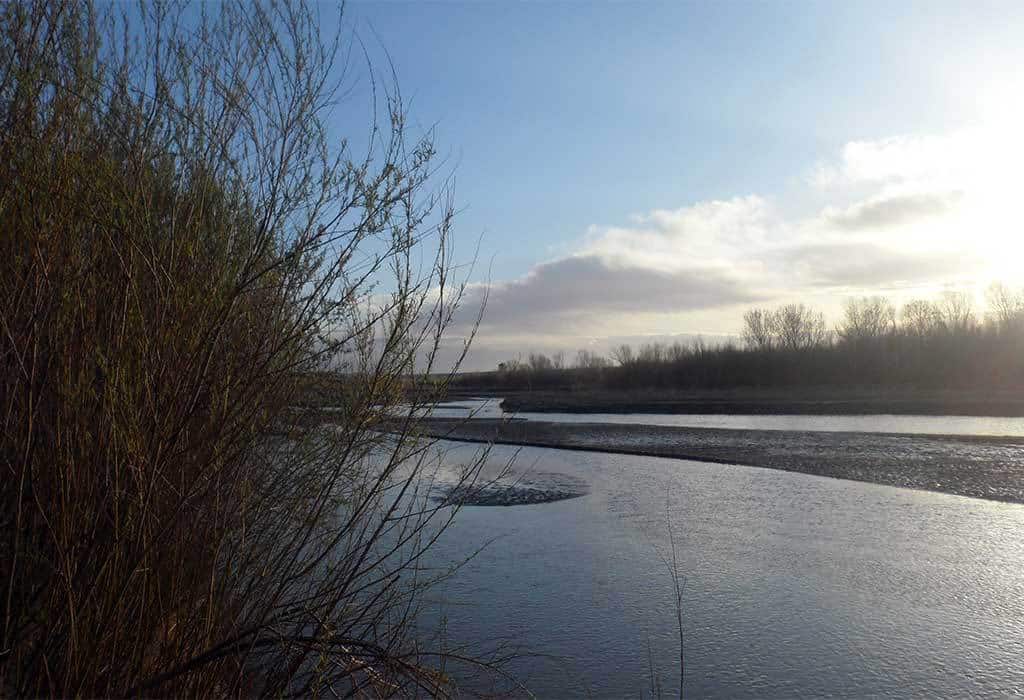As 2018 gets underway, many of us have reflected on our lives and resolved to make changes in the year to come to make our world, our relationships, and our health a little brighter. The New Year brings opportunity and optimism to our old ways and provides a new path forward that can be transformational.

The Rio Grande at dawn as it runs through Bosque del Apache National Wildlife Refuge near Socorro, New Mexico. Photo by Jen Pelz.
At Guardians, we entered 2018 with that same hopeful outlook, eager to continue our efforts to chart a new course for the Rio Grande. While 2018 is predicted to be a very challenging year for the river based on the first monthly stream flow forecast¹ of the year, the dire situation is another opportunity to demonstrate the unsustainability of the status quo², and it provides a new impetus for creative solutions.
The Natural Resources Conservation Service’s January forecast predicts that Rio Grande flows in northern New Mexico just south of Española will be 24 percent of average based on the current snowpack. This is bad. Even in extremely dry years like 2000 and 2013, the forecasted flows in January were 42 percent and 47 percent of average, respectively. This forecast is at or near record lows for the past 40 years of record. If these severely reduced stream flows come to fruition, we will enter unprecedented territory, with disastrous results for the river ecosystem and the fish, wildlife, and plants that depend on the river for their survival.

A decade of monthly stream flow forecasts (Jan-April) showing river flows as a percent of the average stream flow over a 30-year period. Prepared by WildEarth Guardians.
In 2013, when flows were similarly very low, water managers struggled to come up with a plan to meet the needs of the environment and water users. Guardians pushed them every step of the way to make good choices that included the health of the river in the equation.
Climate scientists and federal agencies predict these climate-induced flow declines will be the new normal in the Southwest. A 2015 study by Michael Dettinger, Bradley Udall, and Aris Georgakakos, Western Water and Climate Change, analyzed four of the most iconic and endangered rivers in the West—the Colorado, Rio Grande, Klamath, and Sacramento-San Joaquin Bay Delta—and the authors concluded:
“[T]he Rio Grande is another western basin that is using its water to the maximum, and even more so than in the Colorado, current projections of climate change suggest that the flows that are currently being disputed and wrangled in the Rio Grande are likely to be less and less available for any use as the century wears on. On the whole, the Rio Grande is facing the largest climate change water-supply deficits (relative to historical record) among the four basins considered here.”
Flows in the Rio Grande are predicted to decline by 25 percent in Colorado, 35 percent in the Middle Rio Grande in New Mexico, and 50 percent in southern New Mexico, Texas, and Mexico. The disparity in distributing the impacts of these flow declines is thanks to the 70-year-old agreement—the Rio Grande Compact—that attempted to equitably divide the river’s water among Colorado, New Mexico, and Texas. This law often serves as an excuse to tie the hands of water managers and forces them to continue the existing pattern of water use and storage, despite the cost to the riparian environment.

The dry Rio Grande channel on September 13, 2016, in Bosque del Apache National Wildlife Refuge near Socorro, New Mexico. Photo by Jen Pelz.
The time is now to reform century-old water law and policy. We must come to terms with this new reality for the river and the communities that depend on it. In 2018, Guardians will continue to propose innovative solutions, including:
- Moving low-elevation storage upstream to conserve water (see our report);
- Enforcing environmental laws to ensure a living Rio Grande; and
- Holding federal and state water management agencies accountable for using only a sustainable amount of water.
Stay tuned for regular updates on what we are up to in 2018.
¹ A monthly stream flow forecast is a scientific estimate of the amount of water likely available for river flows that year, based on the measured snowpack.
² The “status quo” on the Rio Grande, as referenced in this piece, is the existing conditions on the river, based on its current management, to meet existing uses by cities, farms, and industry, as well as other legal obligations such as deliveries to downstream states and countries.
